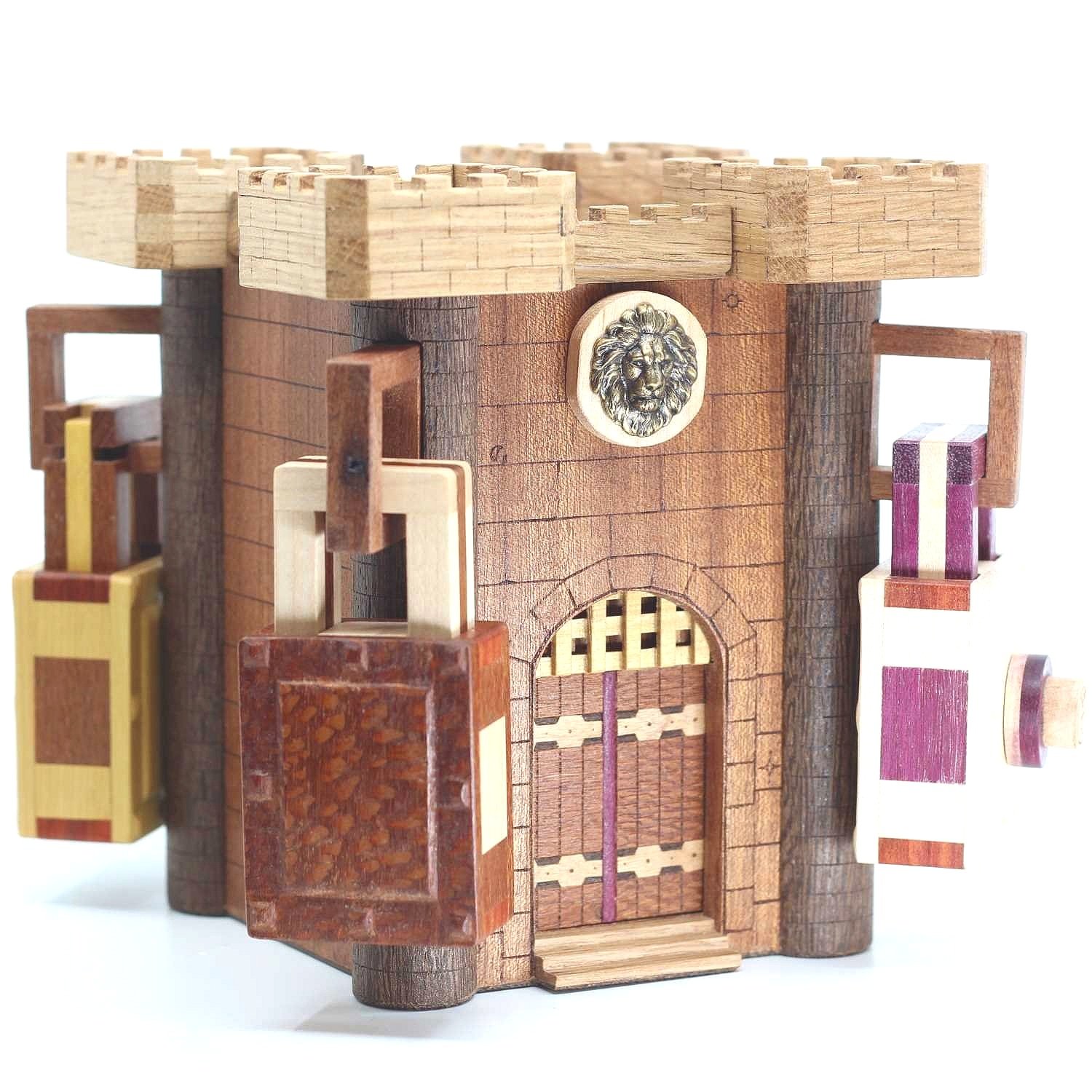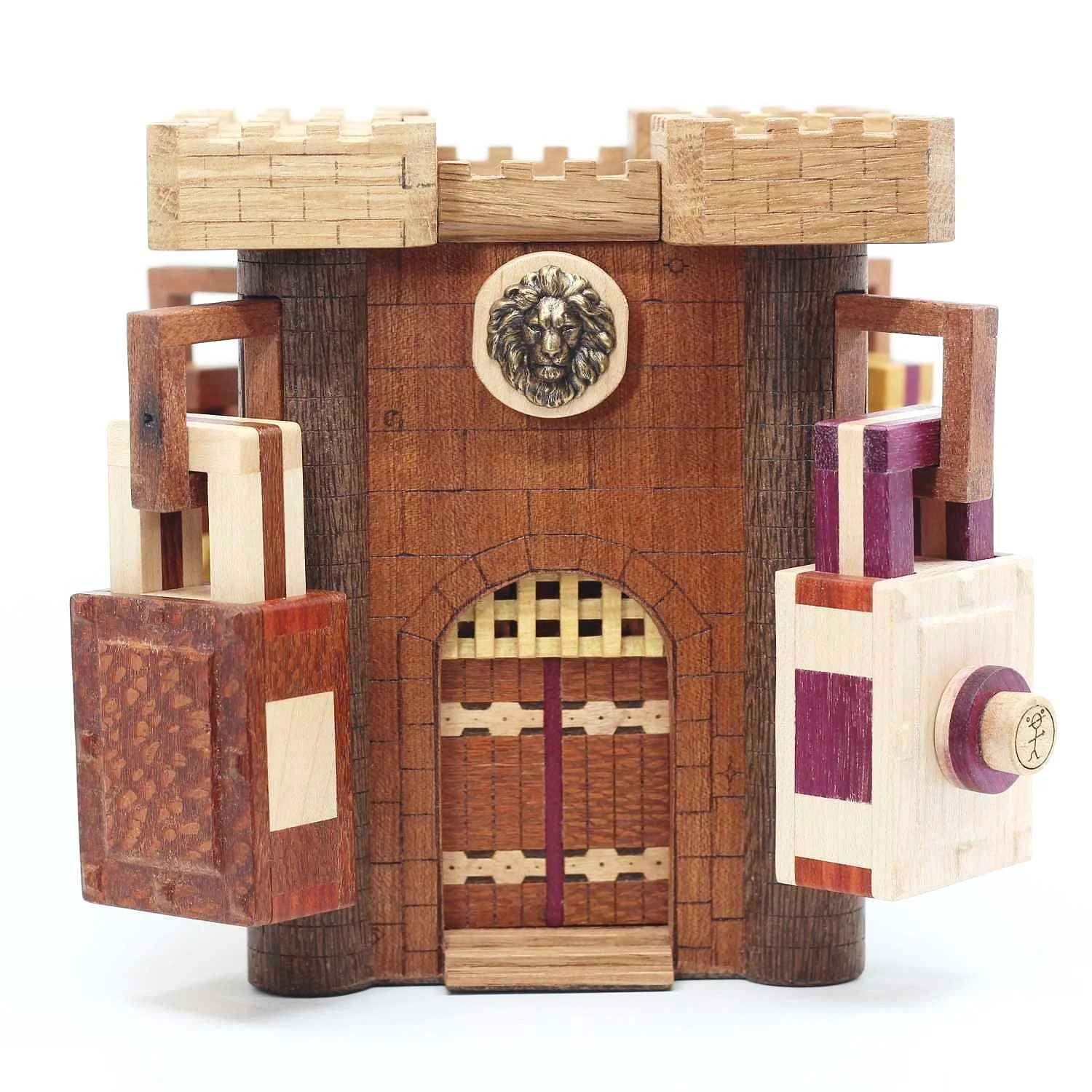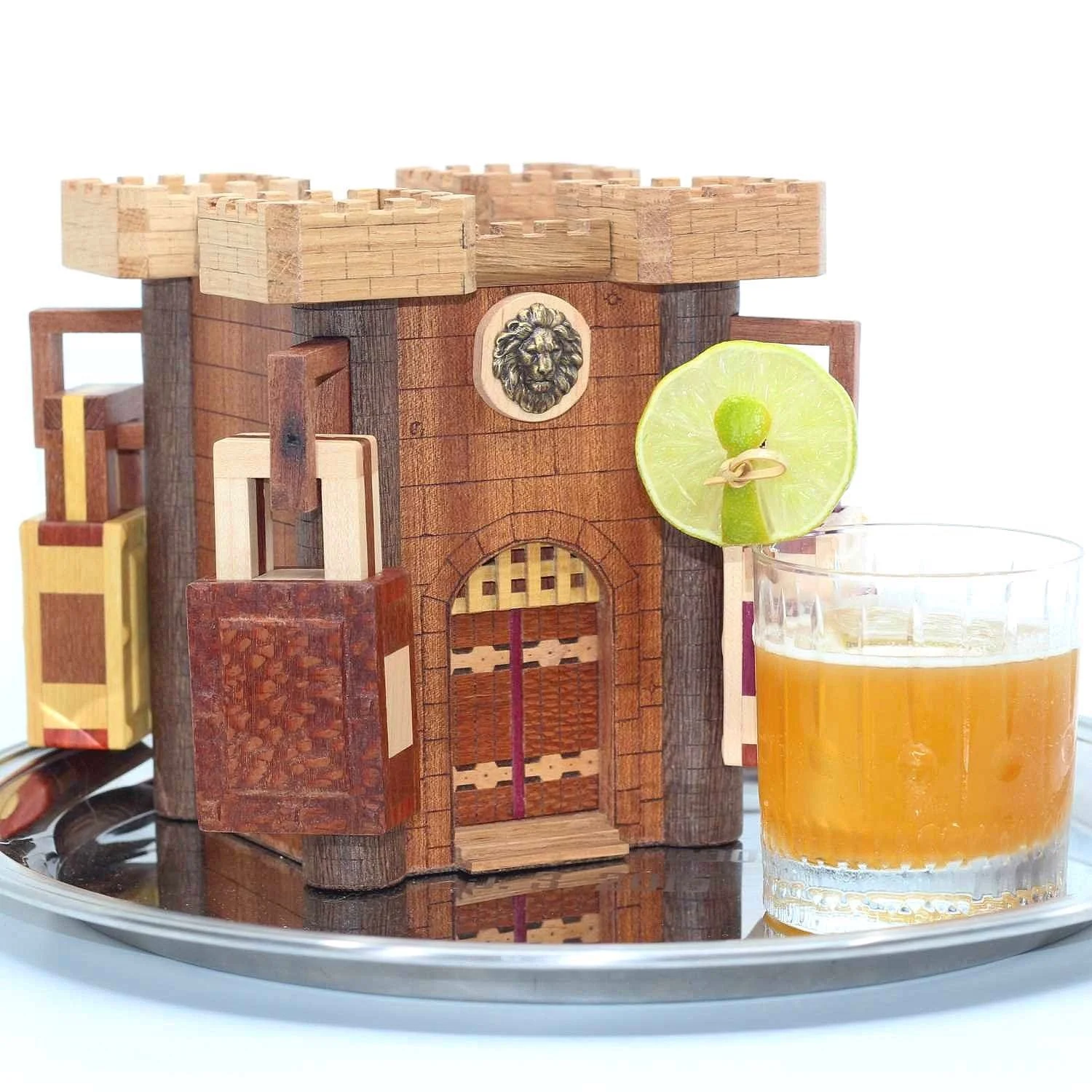Keepsake
Keep Locked
One of the few dates I still recall from my high school European History class is the Battle of Hastings, 1066. The Norman invasion of England brought with it an architectural fortification plan known as motte-and-bailey, which was a fairly simple setup to construct, even for unskilled laborers, while at the same time being a highly effective defensive system. A surrounding ditch or palisade would mark the outer borders, and just within was a walled off courtyard – the bailey. The central feature inside the bailey was a raised hill – the motte – upon which sat a wood or stone tower – the keep – the last line of defense. Stone keeps, which took decades to build, began to serve a political function as well, as a display of nobility, wealth and prestige.
Keep Locked (Stickman No 36 Puzzlebox) by Robert Yarger
Robert Yarger’s newest limited release seems to echo much of this history. Like many of his more complex creations, if not a decade, it nonetheless took him far longer to complete than expected or planned. It is certainly well fortified, featuring layers of defense requiring between thirty to forty steps to reach the inner chamber. It is also a fitting display of showmanship and mastery of the craft, a prestigious achievement by one of the world’s great puzzle box artists.
Can you find the keys to the kingdom?
Rob has built himself a castle. But the story is far more convoluted than that, and like most things Rob designs, came about organically and out of necessity. “The Keep Locked puzzle was a series of events, dictated by necessity, that just simply got out of hand.” Many will be familiar with the original Stickman wood padlock, which secures his Pirate’s Wallet puzzle box and is a clever puzzle in its own right. It should come as no surprise that Rob had a lot more ideas for wood puzzle lock mechanisms, and had originally created a set of four new “padlocks” to stand on their own merits. The locks went together as a set, though, and needed some way to be displayed. Even better would be a display that gave purpose to unlocking the padlocks. The castle, originally, was merely meant as a display stand, believe it or not. Rob is not one for subtlety.
This ones a keeper
Of course, the castle itself presented too many new and interesting possibilities for additional puzzles. “There was always one more cool thing that could be done, and if it can be, then it should be.” Building the castles was a huge undertaking that reached all the way to South America. The main wood used in the castles is Brazilian Walnut, also known as Ipe. It’s not the nicest wood to work with, according to Rob, but had the look and feel that Jesse Born was after for his ancient jungle themed Sundial box collaboration with Rob. They needed so much of it, they bought out every supplier in North America, and still ran out. “We had to track down our own tree in Brazil, ship it to the states, and contract it to be sliced into sheets. The result was a huge palate delivered by flat bed semi that required some figuring to get off the truck, and took up 1/5th of my shop space.” Now they had much more walnut than needed, and Rob had a new problem to solve. The walnut castle walls, and colorful wood locks and spires too, were simply selected as a way to clear out space in the shop. Such necessity led to a perfectly wonderful, whimsical fairy tale castle.
Hold Tight
The castle is full of detail, too. Look closely and you will observe little symbols and markings hidden here or there, clues, perhaps, and more that may be revealed in time. Some of these details posed a new problem. “The spires of the castle were originally to be made from large walnut dowels, but the wood was too hard for mortise chisels to press through, and the rounded surface made it impossible to laser on the stonework pattern. The solution was to instead go with a softer poplar wood, and overlay that with a walnut veneer, which could be laid flat for the laser.” One more puzzle was what to call this “padlocked castle”. Early on, Rob asked me for any ideas, and a quick bit of research led me to Lochmaben Castle, a ruin in the county of Dumfries and Galloway, Scotland. The old motte and bailey castle sits at the south end of Castle Loch, which seemed like a promising name. Castle and locks, yes, but there was no actual lake here, although Rob had in fact originally envisioned a moat with an additional mechanism for the puzzle. He mulled it over for a bit, and locked onto the perfect name. “The name was right there the whole time.”
Lock and Key by Summer Voelker
I say it’s high time for a cocktail, to toast this crafty keep and creator. The drink can be found in the pages of Gary Regan’s Annual Manual for Bartenders, 2011. I think having an annual manual has a nice rhyme to it, don’t you? Gary was a legend of the spirits industry who held yearly educational seminars and famously stirred his creations with … his finger. His personal copies of his cocktail books were likely stained with boozy fingerprints and could get you tipsy just from reading. The drink was created by Pittsburgh’s Summer Voelker of Salt of the Earth.
The keys to this lock
This cocktail is hard to classify. The bourbon and vermouth would get you a Manhattan. The addition of the amaro, in this case the unusual Strega, has us heading into Negroni territory. Strega is an Italian herbal liqueur with a distinctive bright yellow color derived from saffron. It has been made in the town of Benevento, long known as the “City of Witches”, since 1860, which is how it got its name. Prominent flavors from the seventy botanicals and spices used to distill it include mint, juniper, cinnamon and saffron. Recipes for this cocktail allow the substitution of Strega for yellow Chartreuse, instead, which is how I made it, although each will produce a very different drink. If things had stopped there it would be interesting enough, but the addition of lemon changes it further into a fascinating sour that is ripe for autumn. I took the liberty of embellishing mine with some sapele wood bitters as well. I’m not keeping this one under lock and key – and neither should you. Cheers!
Locking down this pair
Lock and Key by Summer Voelker
1 ½ oz bourbon
½ oz Strega (or yellow Chartreuse)
½ oz Carpano Antica (sweet vermouth)
½ oz lemon
3 dashes Fee Bros Whiskey Barrel Bitters
Mint leaf
Shake ingredients together with ice and strain into a favorite glass. Garnish with bitters and a mint leaf, or a lock and key lime wheel.
explore more:







